
 |
|
|
#1 |
|
Member
Join Date: Dec 2004
Location: What is still UK
Posts: 5,940
|
I got this rather interesting bayonet today. I had been after it for some time. Not particularly cheap at around 60 portions but looking at a bigger picture of collecting this type of artifact I am think perhaps it was a very good buy
 . Somewhere from the West African coast? It could be inspired by many bayonet patterns. I think it easy to see the French Gras bayonet? The spike is just over 41cm the handle 9.5cm. How and what type of gun did it fit? The hole in the top and bottom of the handle is 5mm. Did it fit on the ram rod/cleaning stick or could a metal spike be stuck into the wood of the gun and the bayonet stuck on that? Perhaps it was just for show or just a dagger inspired by a bayonet? Puzzling! lots of pics to follow. . Somewhere from the West African coast? It could be inspired by many bayonet patterns. I think it easy to see the French Gras bayonet? The spike is just over 41cm the handle 9.5cm. How and what type of gun did it fit? The hole in the top and bottom of the handle is 5mm. Did it fit on the ram rod/cleaning stick or could a metal spike be stuck into the wood of the gun and the bayonet stuck on that? Perhaps it was just for show or just a dagger inspired by a bayonet? Puzzling! lots of pics to follow.   
|
|
|

|
|
|
#2 |
|
Member
Join Date: Dec 2004
Location: What is still UK
Posts: 5,940
|
Close up.
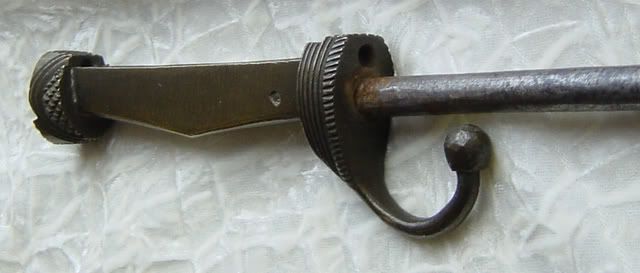  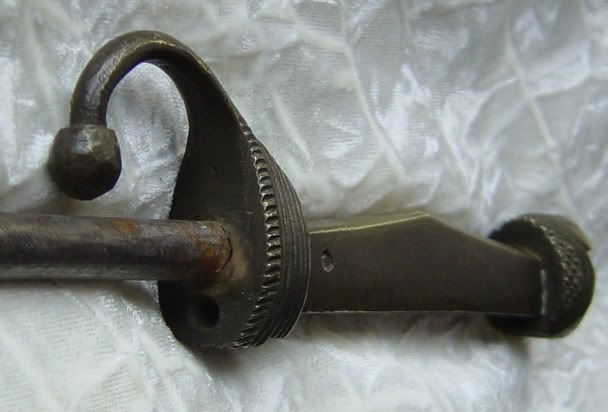 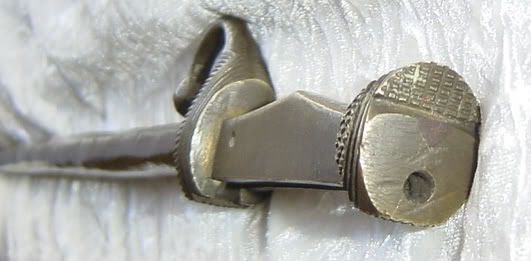
|
|
|

|
|
|
#3 |
|
Member
Join Date: Dec 2004
Location: What is still UK
Posts: 5,940
|
with this other item with a tusk or tooth handle.
   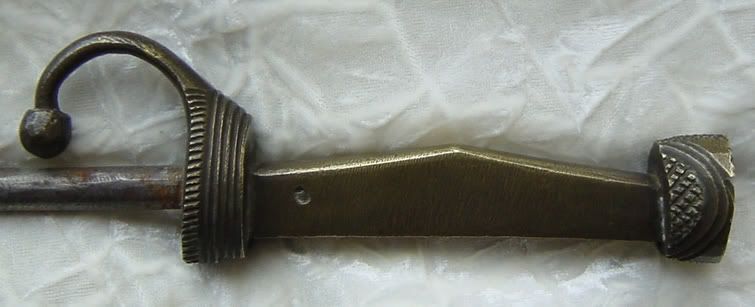 I think it is jolly nice.    
|
|
|

|
|
|
#4 |
|
Arms Historian
Join Date: Dec 2004
Location: Route 66
Posts: 10,745
|
A blow gun bayonet ?
 Seriously though, incredibly unique Tim! I like the rugged mechanical look of the elements. Gotta hit the books! All the best, Jim |
|
|

|
|
|
#5 |
|
Member
Join Date: Dec 2004
Location: What is still UK
Posts: 5,940
|
I could see it fitting on the stick thing on this muzzleloading 1866-74 model. I really know nothing of guns. Would make the rod a little heavy but not completely unwieldy.
http://www.militaryrifles.com/France/Gras.htm |
|
|

|
|
|
#6 |
|
Member
Join Date: Mar 2006
Location: Room 101, Glos. UK
Posts: 4,268
|
looks like a local copy of the french lebel spike bayonet, no. africa?
|
|
|

|
|
|
#7 |
|
(deceased)
Join Date: Dec 2004
Location: Portugal
Posts: 9,694
|
Lebel copy allright Kronckew.
This rifle was used by the French Foreign Legion, right ? So North Africa makes all sense ... Fernando |
|
|

|
|
|
#8 |
|
Member
Join Date: Dec 2004
Location: What is still UK
Posts: 5,940
|
I have been looking in a few books and I think this is the version. I do not see North African work here. French West Africa, perhaps even Dahomey taken from an Amazon when the French took Dahomey
   in your dreams. The book this picture comes from "Swords & Bayonets" R.J.Wilkinnson.Latham suggests that the quillion was removed 1916. Some people think the auther may be a God. in your dreams. The book this picture comes from "Swords & Bayonets" R.J.Wilkinnson.Latham suggests that the quillion was removed 1916. Some people think the auther may be a God. 
|
|
|

|
|
|
#9 |
|
Arms Historian
Join Date: Dec 2004
Location: Route 66
Posts: 10,745
|
That book is a pretty good resource, as shown in your comparison Tim! Wish I had my copy handy
 All best regards, Jim |
|
|

|
|
|
#10 |
|
Member
Join Date: Dec 2004
Location: What is still UK
Posts: 5,940
|
It could equally be the Gras bayonet, both the Gras and the Lebel are not a true round spike. The hole in the handle in this view, a deliberate act? looks like an imitation of the stud on the Gras handle. It might just be inspired by a general bayonet form. There are many versions from several countries which have elements that could have been the model
|
|
|

|
|
|
#11 |
|
Member
Join Date: Mar 2006
Location: Room 101, Glos. UK
Posts: 4,268
|
the french seemed to have a passion for the epee style bayonets, in the gras and the lebel. the gras being more bladelike and the forerunner of the cruciform lebel. they both had the distinctive curved 'blade breaker' lower guard in the 1886 lebel and the last of the french blade-like sword bayonets, the 1874 gras. as the locals were capable of making a bladed copy, and less likely to make a cruciform version, i'd say the lebel is more likely tho it may be a transition type between the two.
the gras bayonet was in use worldwide for a long time: 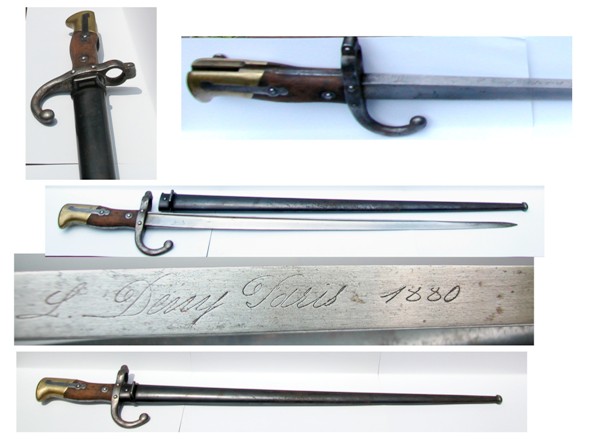 * The French wars during the useful "life-span" of this bayonet were: o French Indo-China in 1873-1874 and again in 1882-1883; o Sino-French War 1883-1885; o Madagascar Wars 1883-1885 and 1895; o 1st Mandingo-French War 1883-1886; o 1st Dahomeyan-French War 1889-1990; o 2nd Dahomeyan-French War 1892-1894; o 2nd Mandingo-French War 1894-1895; o Conquest of Chad 1897-1914; o 3rd Mandingo-French War 1898; o Moroccan War 1907-1912; o World War I (early). * These conflicts obviously overlap periods of use for other French bayonet models, such as the 1866, 1886, 1892 and 1914. the 1886 lebel saw service thru WWII, sometimes in shortened form.   the full kit  and what our ethnographic metalsmith would have seen:  and this, en masse 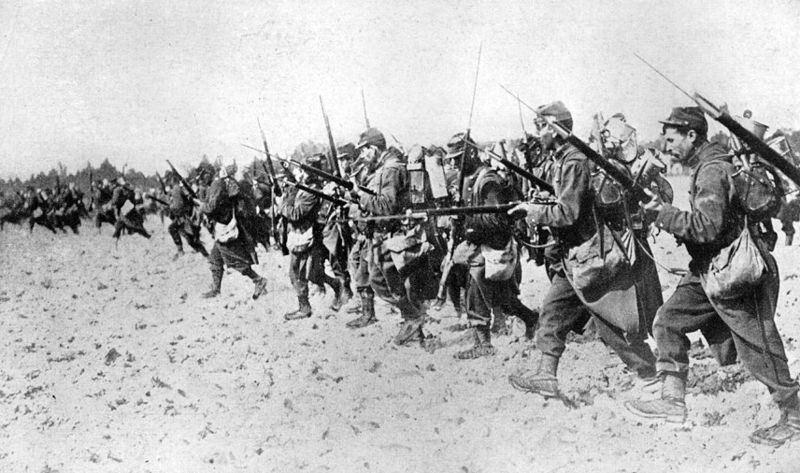 as a final point, the gras had a brass pommel and wooden scales, the lebel all metal, either white metal or brass. Last edited by kronckew; 13th April 2008 at 12:12 PM. |
|
|

|
|
|
#12 |
|
Member
Join Date: Dec 2004
Location: What is still UK
Posts: 5,940
|
kronckew. thank you for such vivid illumination, all helps to make a stronger day dream when handling it. On reflection I think you may have a point about the Lebel inspiration, but I do not think it would have been a problem to make a cruciform blade.
More dream stuff. I think the bayonet is from Ivory Coast and there abouts. http://en.wikipedia.org/wiki/Samory_Tour%C3%A9 Last edited by Tim Simmons; 13th April 2008 at 01:55 PM. |
|
|

|
|
|
#13 |
|
Member
Join Date: Dec 2004
Location: What is still UK
Posts: 5,940
|
kronckew, anybody?
Can you show the cleaning stick on this rifle with a diameter? As I do not think the bayonet would fit. This is just a stabbing weapon based on the bayonet. The holes in the handle are just part of the concept. If you could get the rifle then the bayonets could have been got hold of too? |
|
|

|
|
|
#14 |
|
Member
Join Date: Mar 2006
Location: Room 101, Glos. UK
Posts: 4,268
|
don't have one myself but
picture of the muzzle end, 1886 lebel:  the lebel bayonet appears to seat on the end of the tubular 8 round magazine rather than the protruding rod under it which is quite narrow. (see the pic of the 'legionairre' above). that rod is a stacking 'hook', used in camp to allow the rifles to be tripoded for easy access. the stacking hook was added in the mod. of 1893 and was not found on the earlier 1886 model which required the bayonet be in place to use it's hook for stacking. i'd guess, even tho i suspect the subject item was based on the lebel bayonet, that it was not actually made to fit one. the grooved top of the grip and the pommel base are wrong. may have been made to fit another rifle entirely, or as you say, no rifle at all. i concurr that if they'd been able to capture a lebel rifle they could have taken the bayonet at the same time (unless they were stealing from an arsenal where the bayonets were kept seperately & they did not have the time or inclination to hunt them up) must be a bunch of lebel owners out there (bill marsh?) who could comment further. Last edited by kronckew; 15th April 2008 at 09:18 AM. |
|
|

|
 |
|
|